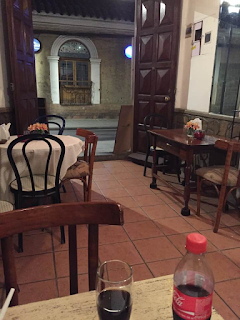An Afternoon in Tarija
After my morning-long wine tour, I was tired and took a
nap. But I do not regularly take long
naps; at most 15 minutes and I am ready to go again. I was only in Tarija for the weekend, so I
needed to get out and see some things.
I was told about a place overlooking the city called the
Mirador de los Suenos. The boy at the
front desk of the hotel did not know what I was talking about, but showed me a
picture of a Mirador with a different name.
Well, that was the one. I found a
taxi driver who agreed to take me there for 10 Bs, though he said it was not
far. I asked if he would wait while I
visited and he said, “of course.”
The Mirador was not open.
So, I was about to give up, feeling I had missed out, because it looked
kinda cool. As I was leaving, I hear
some music in a room at the guard post.
The guard is inside watching TV, his pants unbuttoned and he has his shirt
pulled up exposing his stomach. He was very relaxed. He told
me the Mirador would be open at 3:00. It
was not quite 2:00. I asked if it were
possible for him to open it if I gave him a few extra bolivianos. It cost 1 Bs, and I offered him 10. He said sure and proceeded to open the
Mirador, and then lock it behind me.
The Mirador is cool.
It Is shaped like a wine glass and covered in mirrors. It is not very tall, may four-stories in
total. I climbed to the top and had some
nice views of Tarija and the mountains beyond.
As I was leaving, I noticed that the lower level was covered with wall
art, most intentionally put there, but some put there by teens expressing
themselves.
When I was finished my taxi driver was sitting on the steps
enjoying the sun. He had waited like he
promised. He then drove me to the Plaza
Principal. To my surprise, when I gave
him a 20 Bs note, because the drive plus the waiting was worth that or more, he
gave me back 15! He didn’t want to cheat
me since it was so close. I gave him a
tip for being so nice and taking care of me.
Tarijans are so nice.
A side note. In Santa
Cruz, if you are crossing the street, you had better watch for cars, they own
the road and you need to get out of their way.
In Tarija, they will stop for you and wave you across. It flustered me more than once as I was
rushing across a street. It is just a laid-back quiet kinda place.
I lunched at the Gatto Pardo (Gatto is Italian for cat, with
only one “t” it would be Spanish; pardo means spotted; but I never got the
connection to a jaguar or leopard). It
was the restaurant I ate at the night before.
Families would be eating at the tables outside and friends would stop by
and kiss cheeks, or would honk horns as they drove by. For all the dignity of the place, it had the
feel of home.
I explored a little after lunch. Tarija has two plazas side by side. The one closest to my hotel is the Plaza
Sucre. It seems to be more suited for
young people. There are lots of teens
visiting other teens or eating ice cream.
The night before there were kids break dancing and a street performer,
dressed as a statue.
Two blocks away is the Plaza de Armas, or Plaza
Principal. Like Sucre, it is filled with
beautiful roses, but it also has a gorgeous fountain that the pigeons
love. The Plaza Principal makes me think
of what a Latin American plaza should be like.
There are families enjoying the shade and feeding pigeons. There are the elderly, dressed in their
Sunday best, visiting old friends. There
is the lady selling corn to feed the pigeons who told me she is ugly; I found
her to be the most beautiful thing in the plaza. There is the man selling popcorn. Another taking pictures. A lady selling balloons and her sister
selling cotton candy. There is a man
selling newspapers; and I am amazed at how many, old and young, who buy the
paper. It is the place where you feel
safe. It is what a small city is
supposed to be like.
That afternoon, I was wondering why there was no church in
either plaza. I guess that was the one
thing that stood out so different from what I was accustomed to. While walking around, I noticed a block away,
a beautiful colonial church. I walked
the block to discover a third plaza.
Three plazas side by side! This
plaza seemed quiet and hidden. It was
covered with flowers and the most beautiful little church one could imagine.
I roamed the streets some more and sat for a few hours
writing. In fact, I wrote my first four
blogs on Tarija that afternoon, including this one.
Around 8:00, I was hungry again. I had seen a little pizza place, called Pizza
Macondo. A more eclectic little place
you could not find. Every table was
different. Every chair was
different. The shelves were covered with
interesting artifacts. The ceiling
bedecked with strings of lights and garlands of origami swans. A little girl ran all over the restaurant
taking the flowers off the tables, deciding they were there for her. Nobody ever told her they weren’t. I ordered a locoto pazzo pizza (locoto is a
Bolivian hot pepper, and pazzo is the Italian word for crazy); it was
delicious. The next time in Tarija I
will go back there first.
I sat in the plaza for at least another hour before deciding
I needed to sleep.





















































